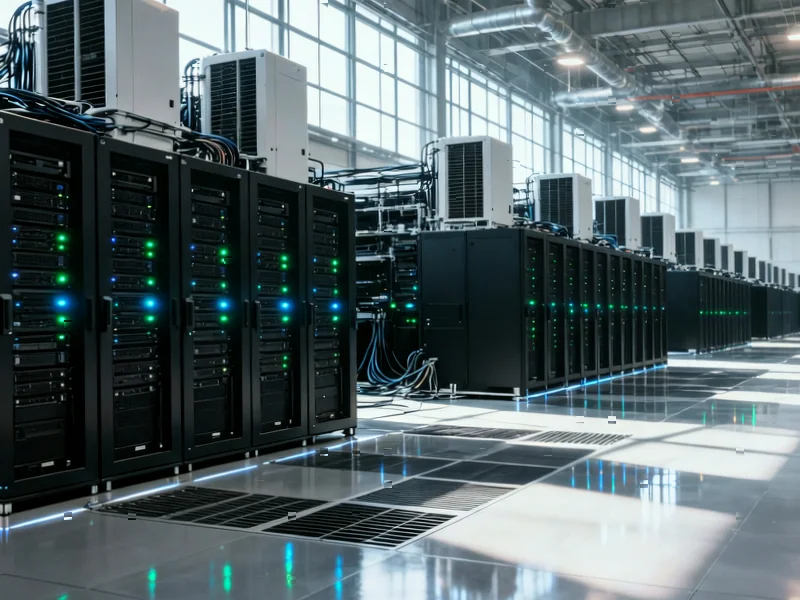According to Fortune, Meta is partnering with private-credit firm Blue Owl Capital on a $27 billion AI data center project called Hyperion, marking a dramatic departure from traditional tech infrastructure funding. Blue Owl owns 80% of the project while Meta holds 20%, with the joint venture issuing bonds that BlackRock purchased for over $3 billion in what became the largest private-debt offering ever. Despite receiving an A+ rating from S&P, the debt carried a 6.58% yield closer to junk bond territory, reflecting the project’s risk profile. The structure allows Meta to build massive AI computing capacity without putting the full debt load on its balance sheet, potentially creating a template for how tech giants will fund the estimated $150 billion in AI-driven data center construction expected in coming years. This innovative approach signals a fundamental shift in how Wall Street intersects with AI infrastructure development.
Table of Contents
The SPV Revolution in Tech Infrastructure
The use of special-purpose vehicles represents a radical departure from how technology giants have traditionally funded their infrastructure. For decades, companies like Meta, Google, and Amazon built data centers using their massive cash reserves or straightforward corporate debt. This SPV approach effectively creates a firewall between the parent company’s balance sheet and the project’s financial risks. What makes this particularly innovative is that it treats data center infrastructure more like real estate development than technology spending – complete with the kind of project financing typically seen in large-scale construction projects rather than corporate IT budgets.
Wall Street’s AI Infrastructure Gamble
The 6.58% yield on what S&P rated as A+ debt reveals the underlying tension in this new funding model. Traditional infrastructure investments typically offer lower yields with correspondingly lower risk profiles. The fact that investors demanded nearly junk-bond level returns for a project backed by one of the world’s most profitable companies suggests significant concerns about execution risk and the fundamental economics of AI infrastructure. This yield spread indicates that capital markets are still pricing AI data centers as speculative technology investments rather than stable infrastructure assets, despite their physical similarities to traditional data center operations.
Echoes of the Telecom Bust
The comparison to the 1990s dark-fiber overbuild highlighted by Global Data Center Hub analysis deserves serious consideration. During the dot-com bubble, telecom companies built massive fiber optic networks based on projected demand that never materialized, leading to bankruptcies and stranded assets. The parallel risk here is that AI workloads might not scale as rapidly as projected, or that the economics of AI services might prove less profitable than current models suggest. If AI adoption plateaus or competing technologies emerge, these massive data centers could become the modern equivalent of dark fiber – expensive infrastructure waiting for demand that never arrives.
The Coming Competitive Landscape Shift
If this funding model proves successful, it could dramatically accelerate the AI arms race. Companies that previously couldn’t compete with the capital expenditure budgets of tech giants might now access similar scale through joint venture structures with institutional investors. This could level the playing field for smaller players while potentially creating an AI infrastructure bubble as capital floods into the space. The real test will come when multiple companies attempt similar financing structures simultaneously – will capital markets maintain their appetite, or will we see the kind of saturation that typically precedes a market correction?
Regulatory and Accounting Implications
This off-balance-sheet approach raises important questions about financial transparency and risk disclosure. While SPVs are legal and widely used in other industries, their application to core technology infrastructure represents new territory for regulators and accounting standards boards. If multiple tech companies adopt this model, it could obscure the true scale of their infrastructure commitments from investors and analysts. The financial reporting implications are significant, potentially making it harder to assess companies’ true leverage and capital commitments in the AI era.
The Future of AI Infrastructure Funding
The success or failure of Meta’s Hyperion project will likely determine whether this becomes the dominant funding model for AI infrastructure or remains an interesting experiment. If Meta can demonstrate that it can reliably monetize AI workloads at scale while managing the operational complexity of a jointly-owned facility, we could see a wave of similar deals. However, if execution challenges emerge or AI economics prove disappointing, this model might be remembered as an ambitious but flawed attempt to financialize technology infrastructure. The coming 12-18 months will be critical as Meta moves from financing to construction to operational deployment of AI workloads.



